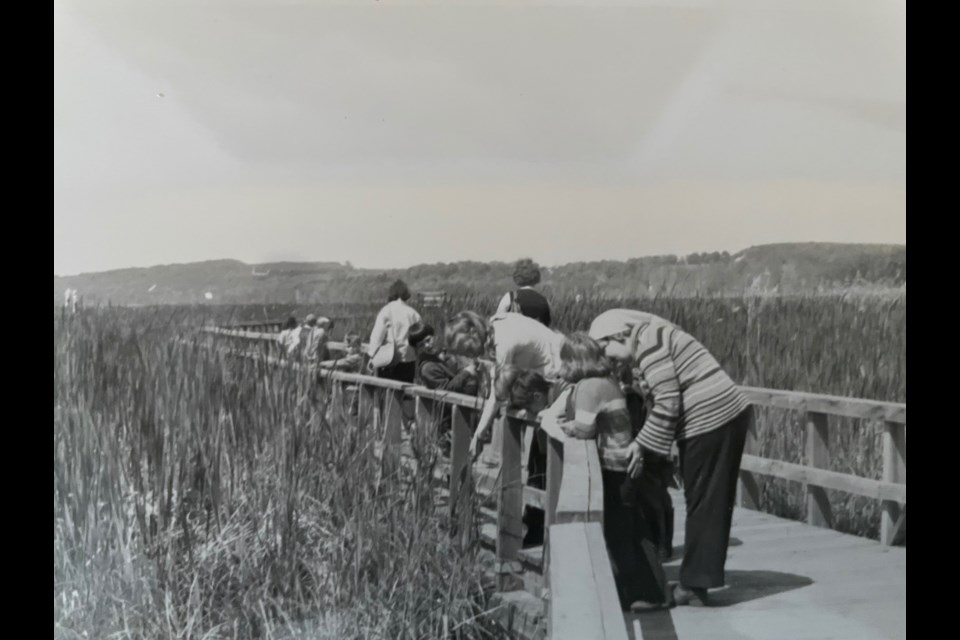Without the hard work of people like Kim Hacker, newly-minted executive director of the Wye Marsh, the 3,000-acre environmentally-sensitive wetland and woodland might not be here today.
In 1985, when federal funding cuts threatened to close the marsh, a group called the Friends of the Wye Marsh came together and took over management of the land.
The then 1,200-acre home to native birds, bees, flora, reptiles, and amphibians, many of which are threatened, was established in 1969 by the Canadian Wildlife Service. The Wye Marsh National Wildlife Area was established in 1978.
When Bob Whittam, lead biologist at the marsh in the 80s, learned about the coming cuts, he, Mike Hines and numerous other passionate environmentalists, including a preteen Hacker, stepped in to save the Wye Marsh.
Whittam went on to become the marsh’s longest-standing executive director, and wrote extensively about the importance of the land for birds in The Birds of Georgian Bay: Sharing the joy of birding.
Part of what volunteers do today at the marsh is sharing that joy of birding by monitoring evidence of egg shells in the many bird boxes that punctuate the boardwalk.
Local birders are encouraged to share their bird sightings, and the centre has a chart showing the various species spotted on the marsh.
“It’s citizen science,” says Hacker. “That’s what makes people understand the significance of their environment and all the creatures that live there.”
Fear and unfamiliarity, says Hackers, keeps people from understanding the environmental significance of snakes or bats — the less camera-friendly animal ambassadors.
The marsh is home to threatened snake species like the eastern hognose snake and the Massasauga Rattlesnake.
“Snakes get a bad rap,” says Hacker as we walk along the boardwalk for this interview. “People may stop to help a turtle cross the road, but it’s not so for snakes.”
One of the leading causes of the decline in threatened snake populations is increasing mortality on the roads and habitat loss.
In fact, there could be fewer than 10,000 adult Massasauga Rattlesnakes left in Ontario, and it’s the province’s only remaining venomous reptile. Its venomous nature gives the snake a bad name, but it poses little to no threat to humans with less than three bites a year reported, and all with full, quick, and easy recovery.
Considered the medicine keeper of the land to the First Nations, the Massasauga Rattlesnake serves as a reminder to tread lightly and take only what we need.
There are a number of other threatened species that call the marsh home, like turtles, and bats — another animal that could use some positive public relations.
Bats contribute to the biodiversity of the marsh. They help pollinate. They drop seeds that grow into trees, and they control the mosquito population.
“How can you hate something that loves to eat mosquitos?” asks Hacker with a laugh.
Kids can learn more about bats in time for Halloween at the Wye Marsh, and it’s in learning about the beauty of the natural world that surrounds us that teaches us to keep it safe.
Those moments are what makes Hacker love working at the marsh.
“The number of conversations you can have with the average visitor on a Saturday about bats, or how to carry a snapping turtle off the road,” says Hacker, “It’s the education piece that is one of the most important things about what we do at the marsh.”
That ability to ask questions while appreciating nature was put in practice when we saw two budding birders from the Netherlands on their first visit to the marsh.
A trumpeter swan couple flew overhead, and without Hacker there to tell us, we may not have known how rare a sighting that was.
With a nearly six-foot wingspan, they are a beautiful sight to behold, and rare because they leave the marsh for the summer and are only now returning for the winter.
The Wye Marsh has a long history of helping the Trumpeter swan population recover.
In 1993, a cygnet named Pig Pen, who was raised on the marsh, found a mate, and they became the first nesting pair of Trumpeters on the Wye Marsh since the late 18th century.
Today, the Wye Marsh is owned by the provincial government, and continues to operate under the management of the Friends of the Wye Marsh. They keep the gates open, and the chickadees well-fed on a blend of provincial funding and private donations.
The marsh runs a clever campaign on social media called Why the Wye Marsh? The answers to why are as vast as the wetland and woodland’s 3,000-acre span.
Take a trip to the Wye Marsh today and find out 'why the Wye Marsh' for yourself. Maybe you’ll become a citizen scientist, too.


